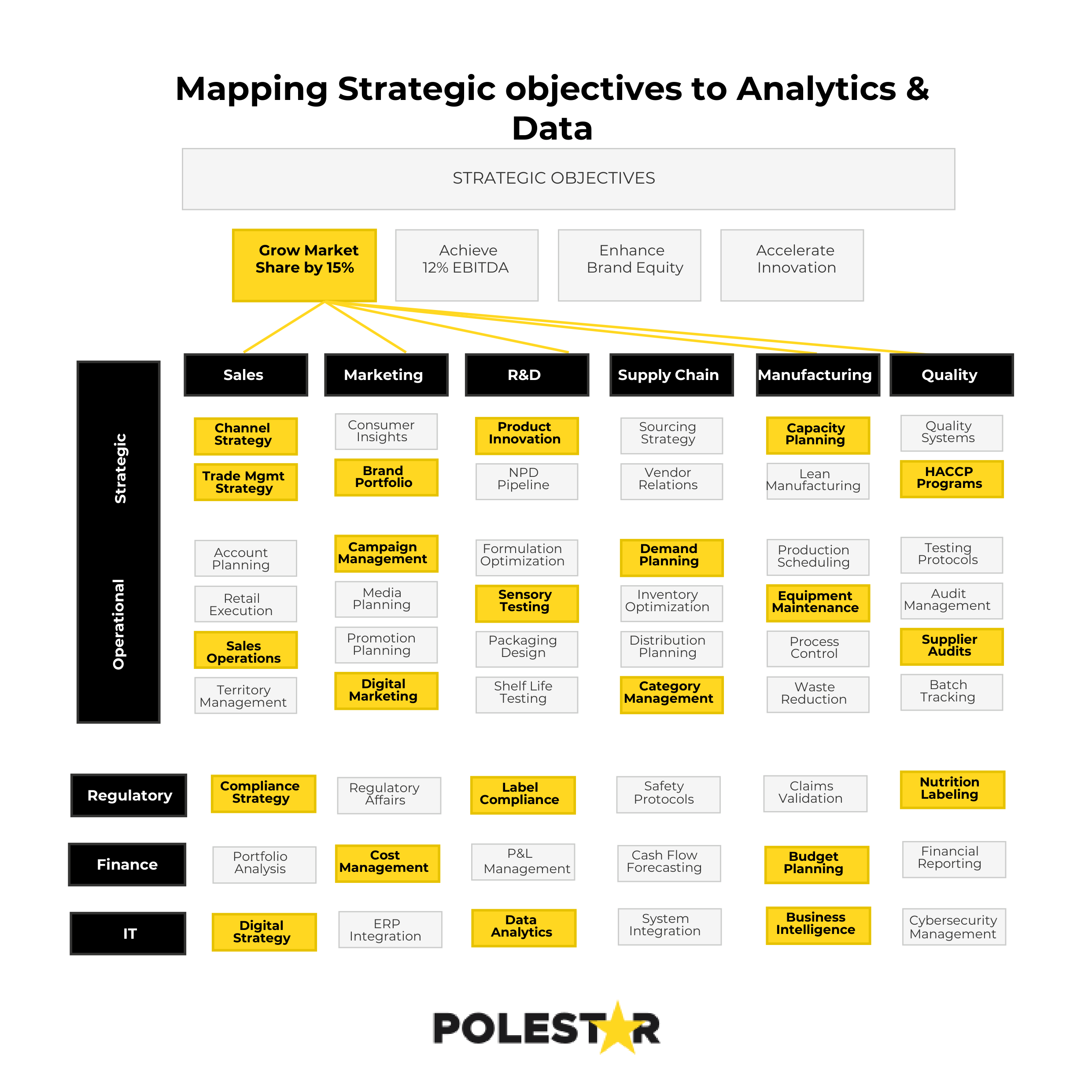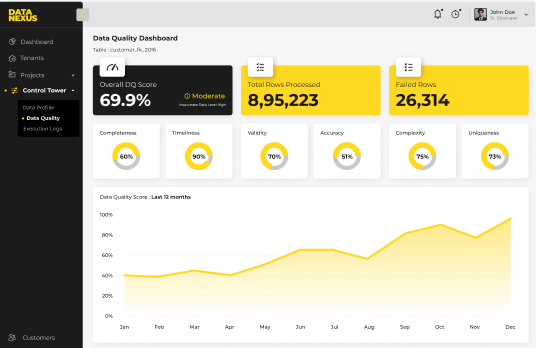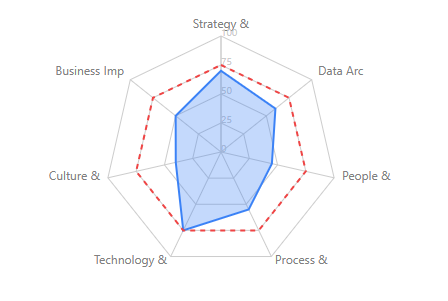
Sign up to receive latest insights & updates in technology, AI & data analytics, data science, & innovations from Polestar Analytics.
In The Art of War, Sun Tzu said, “Victorious warriors win first and then go to war, while defeated warriors go to war first and then seek to win.” This idea of strategic planning ahead is not just for the battlefield —it’s imperative in the business world as well.
Just like a skilled general that depends on intelligence and thoughtful planning to outmanoeuvre opponents, likewise organizations should also utilize the power of a clear data strategy to gain a competitive benefit.
In this blog, we’ll explore some of the best practices for an effective data strategy to help you guide and implement a robust strategy for your enterprises. Let’s get started.
One of the most crucial practices in creating an effective data strategy is to directly connect your business objectives with your data. Every investment in data — whether it’s talent, tools, or time—should clearly support your organizational objectives.
This assists in aligning departments, ensuring everyone grasps how data benefits their work. It’s also significant to define a clear ROI for each initiative. This not only keeps teams motivated but also builds trust in the value of data. Enterprises can sustain transparency and momentum through the monitoring of relevant outcomes and metrics.

Leverage your company’s data strategically through a comprehensive approach that tells you what, when, why, and what next.
Let's Talk About Your Data StrategyEffective data governance starts with structured framework of policies and quality standards and protocols which guarantee data accuracy and security and compliance.
We can go into detail about each of the policies, standards, and procedures from data retrieval to archival, or adherance to GDPR, CCPA, HIPAA etc., but it will be a different article by itself.
So, here’s some of the common metadata capabilities that enable governance are:
This type of clarity eliminates potential risks while diminishing inconsistencies and creating trust in data-driven decisions. The goal is to curate an environment which promotes agility while maintaining control.
The robustness of any data strategy completely depends on how well the organizational data is maintained in terms of accessibility and quality. If the data is inaccurate, inconsistent or incomplete, even the foremost analytics tools will not offer any business-critical insights.
Regular data health checks: Kickstart by scheduling audits on a regular basis, identify duplicate records, outdated entries, and system inconsistencies. Utilize automated quality checks and validations at every entry point to identify errors before it affects the downstream process.
Encourage a culture of shared responsibility: Capitalize teams to flag data related problems and offer feedback.
Make integration a strategic goal: Data plunged in silos limits your capability to have an overall view. Ensure that your systems collate with your teams and have authorization to the right data at the right time.
Pro Tip: Use modern data platforms such as- Data Nexus that support automated quality monitoring and real-time integrations. This not only decreases manual overhead but also make sure that your data remains consistent and trustworthy organization-wide.

To make a data-centric shift, enterprises are required to go beyond hiring data roles such as data stewards, architects, and engineers. What’s equally significant is instilling a culture where every employee—regardless of its function—feels certain while using data in their daily decisions.
How to improve it? Begin by setting up a dedicated Data & Analytics CoE, with models like:
Centralized for tighter governance and uniform practices,
Federated to empower business units with more contextual agility, or
Hybrid to balance scale with flexibility.
Choosing between CoE models should be based on factors like:
Additionally, break down silos by offering governed self-services access. When teams across business functions easily trust and access the data, they're more likely to utilize it to drive measurable business results.
Scalability in data architecture is all about building systems and processes that cater to the increasing workloads and data needs.
With cloud based solutions as the base line for scaling, the two most common methods to do this include:
Some of the key characteristics and parameters to determine the scalable architecture strategy include:
For example, Microsoft Fabric provides such scalable architecture with:
Organizations should know their starting point — their current analytics maturity level — before outlining their desired future state. This assists them set obtainable goals and make realistic, incremental steps to be more data driven and use advanced methodologies such as agentic AI or gen AI to transform their business.
Though there are multiple assessments available in the market, the one we use can be regarded as one the most comprehensive ones:
It consists of elements around:

How data assessments help with data strategy, they help you with:
With privacy regulations and data breaches making headlines in the present scenario, ensuring privacy and security is no longer just a tech imperative — it’s a business concern. A well thought-out data strategy must involve solid measures to meet compliance requirements, protect sensitive information, and build stakeholder trust.
Modern data platforms such as Microsoft Fabric offer solid, enterprise-grade security abilities that assists enterprises confidently manage their data within a unified analytics platform. Features like these are embedded into the systems:
By implementing this level of privacy and security, organizations can innovate and grow with confidence, understanding their data is compliant and protected.
As a forward-thinking organization, integrating Agentic AI in your data strategy can critically enhance automation, adaptability, decision making across the data lifecycle.
Despite conventional automation tools, AI agents can proactively make decisions, plan tasks, and execute multiple workflows based on real-time inputs and business goals.
Here are some of the practical use cases where Agentic AI can be of immense value:
By integrating Agentic AI into your data ecosystem, your organization is not just automating tasks but building adaptive, intelligent systems that respond to business requirements in real time.
Experience the future of intelligent data strategy with Agentic AI at the core.
Try Agenthood AIAs the world develops technologically, companies need to adopt new data strategies to protect and use their data. Thus, a proper data strategy roadmap ensures efficient use of data. It will achieve the organizational objective by creating effective methods and practices to manage shared information across the enterprise.
We at Polestar Analytics help organizations to make well-informed business decisions, improve internal operations and customer experiences, and drastically reduce costs to unlock the valuable information that the enterprise holds. Get in touch with our data analytics consultant to explore our offerings today!
About Author

Content Architect
The goal is to turn data into information, and information into insights.